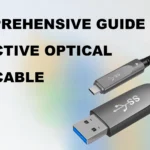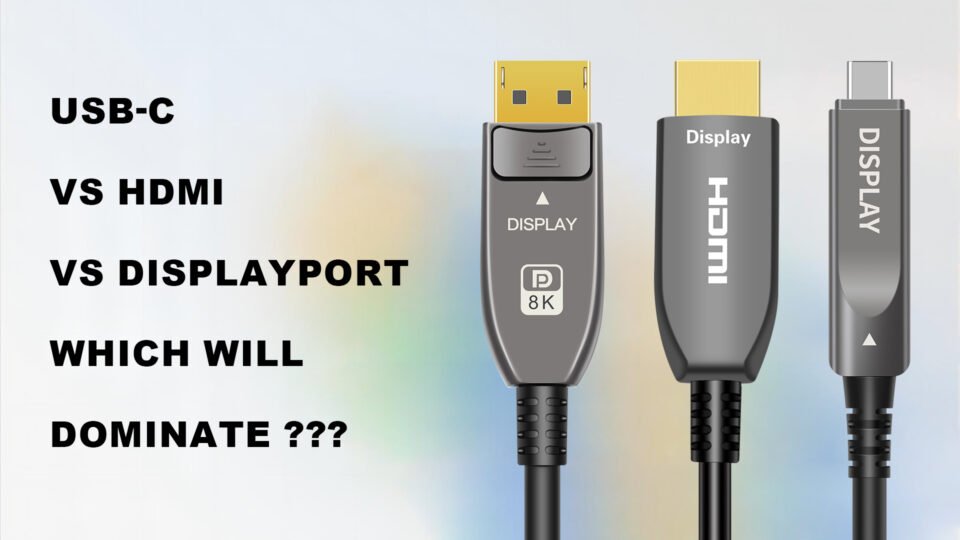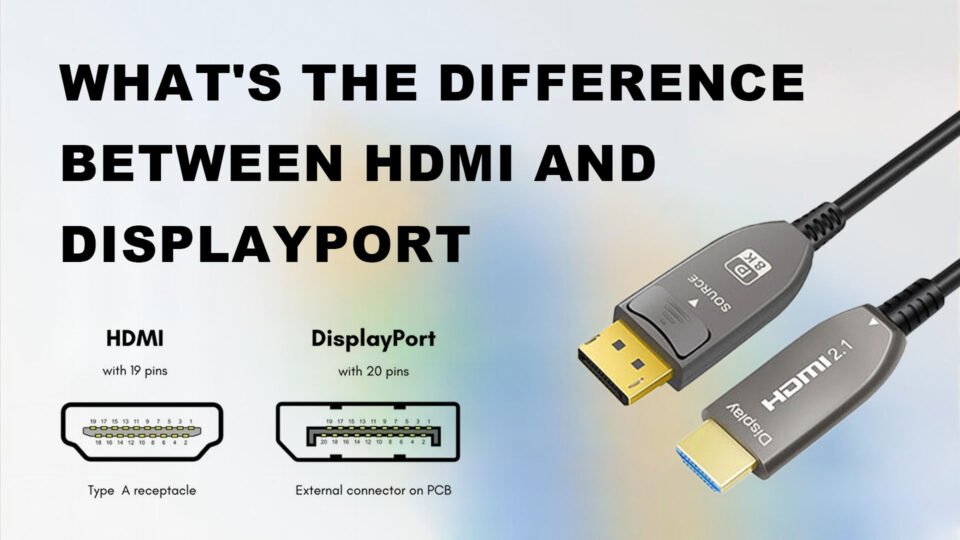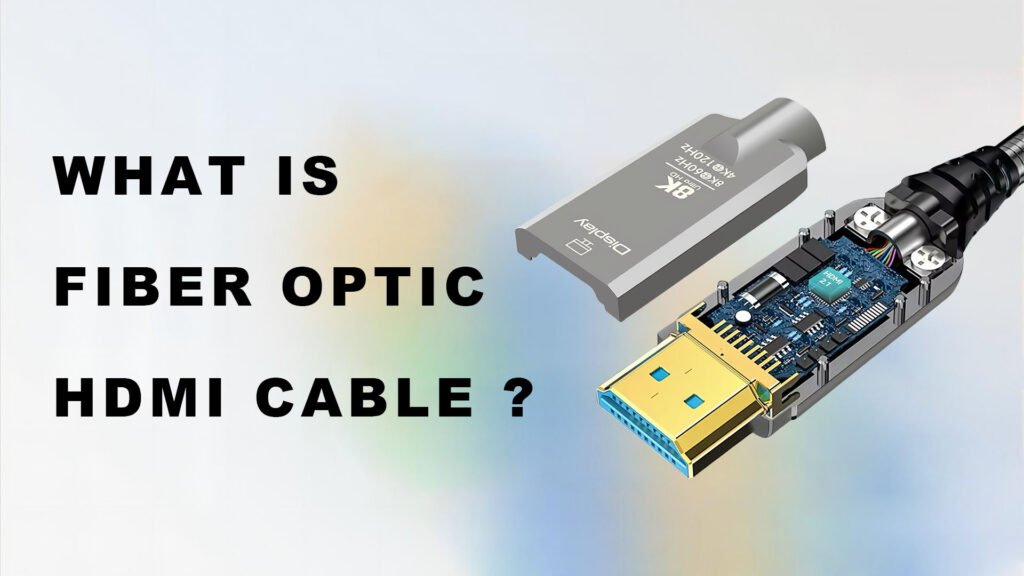
In the rapidly evolving field of digital audio and video technology, connection solutions are critical to providing the quality and performance needed for modern applications. HDMI (High-Definition Multimedia Interface) has been a mainstay of digital transmission for high-definition audio and video. As consumer electronics and professional AV systems push the boundaries of resolution and color depth, traditional copper HDMI cables face limitations, particularly in terms of distance and signal attenuation. The emergence of fiber optic HDMI cables—a leap in innovation—provides a future-ready solution for high-quality signal transmission.
Cavi HDMI in fibra ottica use light instead of electrical signals to transmit data, offering several distinct advantages over traditional copper cables. Essentially, these cables are made of optical fibers designed to transmit data over longer distances while maintaining signal integrity. This technological advancement is crucial as audiovisual content continues to evolve towards more demanding formats like 4K, 8K, with high dynamic range (HDR), immersive surround sound formats, and other high-bandwidth considerations.
Moreover, because Active Optical Cable HDMI use light to transmit data, they are inherently immune to electromagnetic interference (EMI) and radio frequency interference (RFI), two common issues that affect copper cables’ performance. This feature not only ensures more stable and clearer signals but also extends the usability of these cables to environments where electronic interference is prevalent.
Beyond these practical benefits, fiber optic HDMI cables offer enhanced bandwidth and speed, making them an ideal solution for demanding applications such as professional AV setups, high-end home theaters, corporate infrastructures, and other scenarios requiring reliable high-speed data transmission. As the demand for higher resolution displays and more immersive entertainment experiences grows, the role of fiber optic HDMI cables will undoubtedly expand, providing the necessary infrastructure to support these technological advancements.
In this article, we will delve into what Active Fiber HDMI Cable are, explore their advantages, compare them with traditional copper HDMI cables, and consider their various applications and future potential in the competitive world of digital connectivity. Through this exploration, we aim to elucidate why fiber optic HDMI cables play a more critical role in ensuring high-quality, reliable, and efficient digital signal transmission.
What is HDMI?
Before understanding what Active Fiber HDMI Cable is, it is necessary to understand what HDMI is. HDMI (High-Definition Multimedia Interface) is a widely used interface standard for transmitting high-definition audio and video data between devices.

History and Evolution of HDMI
1.Origin (2002): HDMI was first introduced in December 2002 by a consortium of seven companies: Hitachi, Panasonic, Philips, Silicon Image, Sony, Thomson, and Toshiba. The goal was to create a compact interface for transmitting high-definition video and audio signals, replacing older analog interfaces like VGA and component video cables, as well as digital interfaces like DVI (Digital Video Interface). At the time, HDMI was designed to provide a standardized and simplified connection that could support both video and audio data through a single cable. The development of HDMI was aimed at meeting the growing demand for high-definition content driven by the emergence of devices such as HDTVs, Blu-ray players, and video game consoles.
2.HDMI 1.0 (2003): The first version of HDMI, HDMI 1.0, was released in 2003. This version supported a maximum bandwidth of 4.95 Gbps, enough to transmit 1080p video at 60Hz and uncompressed 8-channel audio.
3.HDMI 1.1 to 1.4 (2004-2009): Over the following years, the HDMI standard evolved continuously. HDMI 1.1 supported DVD-Audio, and HDMI 1.2 added support for One Bit Audio (SACD). With HDMI 1.3 (2006), the bandwidth was increased to 10.2 Gbps, supporting higher resolutions, deep color (30-bit, 36-bit, and 48-bit), and Dolby TrueHD/DTS-HD audio formats. HDMI 1.4 (2009) introduced support for HDMI Ethernet Channel (allowing devices to share an internet connection) and, notably, added support for 4K resolution (3840×2160) at 24Hz and 30Hz, as well as an Audio Return Channel (ARC) for two-way audio communication between devices.
4.HDMI 2.0 (2013): Released in 2013, HDMI 2.0 was a major update that increased bandwidth to 18 Gbps, allowing for 4K video at 60Hz. It also introduced support for up to 32 audio channels, a 21:9 aspect ratio, dynamic auto lip-sync, and improved handling of 3D video.
5.HDMI 2.1 (2017): Released in 2017, HDMI 2.1 is the current main standard. It significantly increased bandwidth to 48 Gbps, supporting 8K video at 60Hz and 4K video at 120Hz, along with dynamic HDR, which allows content to adjust its brightness and contrast frame by frame. Additionally, HDMI 2.1 supports features like Variable Refresh Rate (VRR) for smoother gaming experiences, Enhanced Audio Return Channel (eARC), and Auto Low Latency Mode (ALLM). HDMI 2.1 also introduced support for 10K resolution, although this is more of a future-proof feature as few consumer devices currently support it.
6.HDMI for Various Devices: HDMI has become the standard of choice for connecting devices such as TVs, computers, game consoles, projectors, and streaming devices. As the demand for higher resolution and faster refresh rates continues to grow (especially with the rise of gaming and virtual reality), HDMI continues to evolve.
7.HDMI in Modern Devices: Today, most consumer electronics are equipped with HDMI. Devices like the PlayStation 5, Xbox Series X, 8K TVs, and modern computers use HDMI 2.1 to take full advantage of high frame rates and enhanced audio and video capabilities.

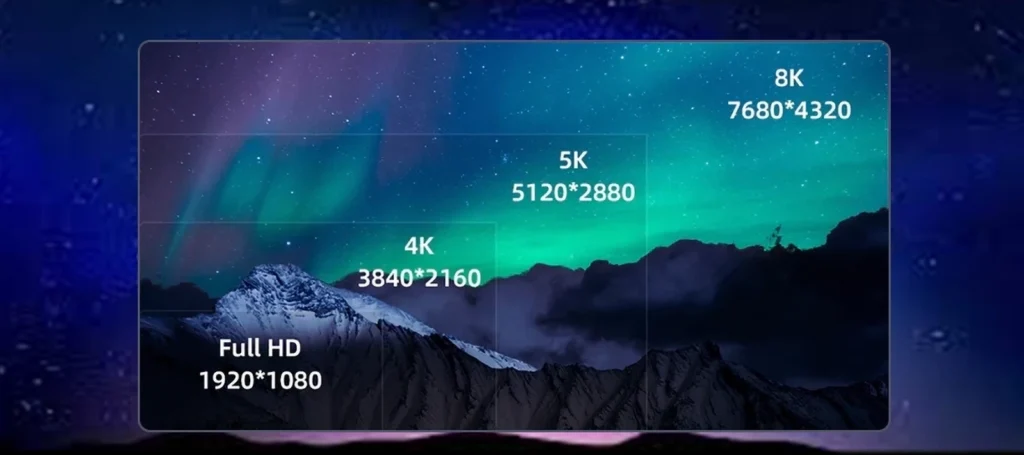
Main Features of HDMI
High Bandwidth: HDMI supports very high data transfer rates, making it ideal for high-definition and ultra-high-definition video.
Single Cable for Audio and Video: HDMI transmits both video and multi-channel audio through a single cable, simplifying the connection process.
Support for Advanced Audio Formats: HDMI supports advanced audio formats such as Dolby TrueHD E DTS-HD Master Audio.
Consumer Electronics Control (CEC): Allows control of multiple HDMI-connected devices with a single remote control.
HDCP (High-bandwidth Digital Content Protection): Provides content protection for transmitted video, ensuring digital content is protected from piracy.
What is a Fiber Optic HDMI Cable?
HDMI Fiber Hybrid Cable are a combination of fiber optic technology and HDMI technology. They have the same attributes as standard HDMI cables but overcome some limitations that standard HDMI cables cannot. Fiber optic HDMI cables represent a significant development in the field of digital connectivity. These innovative cables use light instead of electricity to transmit high-definition audio and video, capable of converting electrical signals to light signals and back, thus supporting efficient and effective data transmission over long distances.
Traditional HDMI cables are typically made of twisted copper wires and are not suitable for long-distance audio and video transmission. When transmitting over long distances, traditional HDMI cables may experience signal loss or attenuation, whereas fiber optic HDMI cables are designed to address this issue.
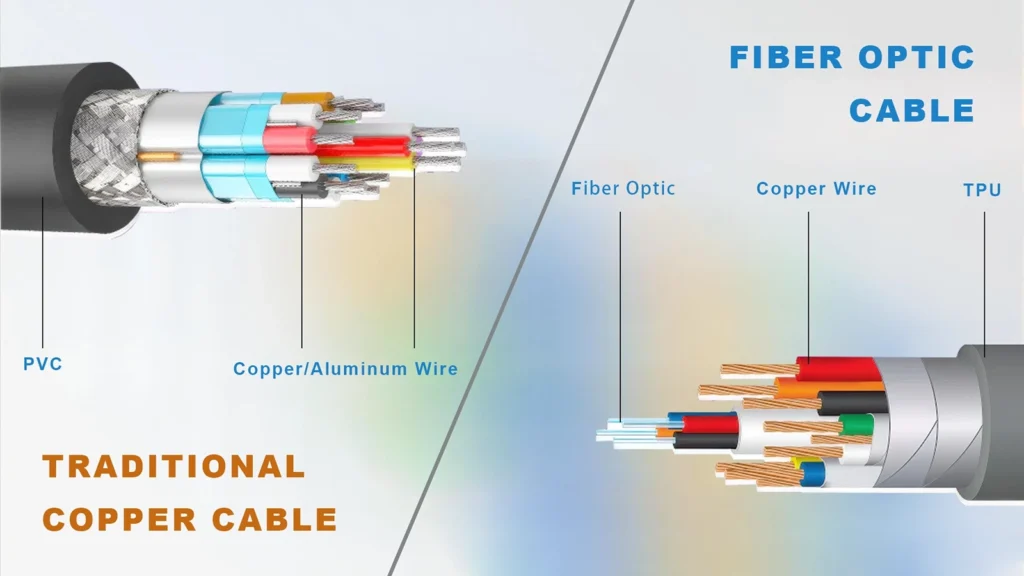
Cavi HDMI in fibra ottica, also known as HDMI Active Optical Cables (HDMI AOC), utilize the same protocol as traditional copper cables. Although they appear similar, they differ significantly in structure. HDMI Fiber Hybrid Cable integrate fiber optic and HDMI technology and are composed of multiple glass or plastic fibers. Most fiber optic HDMI cables on the market consist of four optical fibers for data transmission and seven to nine copper wires (one for power, one for Consumer Electronics Control (CEC), two for Audio Return Channel (ARC/eARC), and the rest for Display Data Channel (DDC) signals). These cables use light instead of electricity to transmit signals, providing resistance to interference and crosstalk.

Components of Fiber Optic HDMI Cables
Fiber optic HDMI cables consist of several key components:
1.Optical Fiber: The core of each cable is the optical fiber itself, typically made from glass or plastic. These fibers enable zero impedance and uncompressed signal transmission, facilitating the transfer of optical signals over long distances without attenuation, with a maximum range of up to 500 meters. The Armored AOC HDMI Cable’s fiber are encased in 304 armored steel and TPU/PVC protective layers to ensure durability E flexibility.
2.Transceivers: Both ends of a fiber optic HDMI cable are equipped with transceivers. These transceivers integrate optoelectronic conversion circuits that convert electrical HDMI signals into optical signals for transmission through the fiber, and then back into electrical signals for input into the receiving device.
3.Connectors: Despite the medium changing from electrical to optical, the ends of fiber optic HDMI cables retain standard HDMI connectors, ensuring compatibility with all HDMI-supported devices.
How Do Fiber Optic HDMI Cables Work?
Cavi HDMI in fibra ottica represent a significant innovation in digital connectivity, utilizing light to transmit information at remarkable speeds with minimal signal attenuation. To understand how HDMI cables work, it’s essential to explore the operational principles of these cables, including their conversion processes, transmission mechanisms, and technological innovations.
Working Principle of Fiber Optic HDMI Cables
1.Signal Conversion and Transmission:
Transmission Source: The process begins with a source device, such as a Blu-ray player, gaming console, or computer. The HDMI port on this device outputs electrical signals, which include video and audio data.
Electrical to Optical Conversion: A small microchip integrated within the fiber optic HDMI cable connector converts the electrical HDMI signal into an optical signal. This complex conversion is crucial because optical signals are immune to electromagnetic interference, a major advantage over traditional copper cables.
2.Transmission Through Optical Fiber:
Fiber optic HDMI cables use thin glass strands to transmit data via light pulses, typically generated by low-power lasers. The core principle of fiber optic HDMI cables is to utilize light and the principles of reflection and refraction within the glass strands to transmit data. This method distinguishes them from copper-based HDMI cables, which use electrical pulses sent through copper wires to transmit data.
Inside the cable are numerous glass strands thinner than a human hair, encased in traditional copper wiring. When data transmission is required, the source device converts electronic audio and video signals into a series of light pulses. These light pulses are then guided into the glass strands, while the surrounding copper wires are used for non-signal functions, low-speed data, or display handshake functions.
The key element here is the principle of total internal reflection. As light travels through the core of the glass strand, it reaches the boundary between the glass core and the surrounding cladding, which has a lower refractive index. This change in refractive index effectively traps the light within the core, causing it to reflect continuously along a zigzag path at the core-cladding interface.

Fiber optic HDMI cables utilize internal reflection to ensure minimal signal quality loss as light pulses (data) travel through the glass strands. These light pulses then reach the target device through the cable. At the receiving end, the light pulses are converted back into the original audio and video signals, providing high-quality and efficient transmission. The core function of fiber optic HDMI cables is the conversion of electrical signals to optical signals and vice versa. This conversion is crucial for transmitting high-definition audio and video data through the fiber optics within the cable.
Once converted to light, these signals travel through the optical fibers in the cable. Unlike copper wires, optical fibers can transmit light signals over long distances without common issues such as signal loss or attenuation, thanks to their excellent attenuation properties. Optical fibers are typically made from high-purity silica glass or plastic, encased in protective sheaths to prevent physical damage and environmental factors.
3. Optoelectronic Conversion:
Upon reaching the other end of the cable, the light signals are converted back into electrical signals by another microchip. This conversion is necessary to feed data into the HDMI input port of the receiving device, ensuring compatibility with all standard HDMI devices.
This seamless conversion process allows fiber optic HDMI cables to integrate smoothly with existing equipment while providing enhanced performance over longer distances.
Vantaggi dei cavi HDMI in fibra ottica
In the realm of digital connectivity, fiber optic HDMI cables are an excellent choice for transmitting high-definition audio and video signals. They are designed to overcome the limitations of traditional copper HDMI cables, offering a range of advantages that meet the needs of both consumers and professionals.
1. Long-Distance Transmission
One of the most notable advantages of fiber optic HDMI cables is their ability to transmit high-resolution audio and video signals over long distances without significant quality loss, with virtually no signal attenuation. Unlike copper HDMI cables, which may experience signal loss beyond 10-15 meters, cavi in fibra ottica can maintain performance over distances of up to 500 meters or more. This feature is particularly valuable in large venues such as auditoriums and stadiums, expansive spaces, commercial and educational settings, and large-scale installations of integrated AV systems in residential environments.
2. High Bandwidth and Resolution Support
Compared to copper HDMI cables, Ultra-High-Definition AOC HDMI Cable support much higher bandwidth, currently reaching up to 48Gbps. This allows them to easily handle high-resolution video formats such as 4K and 8K, High Dynamic Range (HDR), and deep color depths, while also supporting high refresh rates E eARC. This capability enables the transmission of higher-resolution audio, including Blu-ray formats like Dolby TrueHD E DTS HD Master audio, along with multi-channel audio and other high-bandwidth applications. Furthermore, they are future-proof and capable of adapting to technological advancements in multimedia content delivery. Their high bandwidth capacity ensures that users can enjoy clear video and immersive audio without experiencing delays or compression artifacts sometimes associated with lower-bandwidth connections. While there are currently no displays with higher resolutions and refresh rates, the HDMI 2.1 standard theoretically supports up to 10K resolution and 120Hz refresh rates when utilizing display stream compression and chroma subsampling.

3. Immunity to Electromagnetic Interference
One of the significant advantages of fiber optic HDMI cables is their immunity to electromagnetic interference (EMI) and radio frequency interference (RFI). Since fiber optic cables use light instead of electrical signals to transmit data, they do not pick up noise from nearby power lines, appliances, routers, and other devices like traditional copper HDMI cables might, especially over long distances. This ensures high fidelity in audio and video transmission, making fiber optic HDMI cables ideal for environments with high electronic interference, such as data centers, broadcast studios, and specialized medical or industrial settings.
4. Enhanced Security
The physical properties of fiber optics make them more secure than copper cables. The light signals transmitted through fiber optic cables are harder to intercept than electrical signals in copper wires, making them more suitable for transmitting sensitive data.
5. Durability and Flexibility
Fiber optic HDMI cables are generally lighter and more flexible than copper cables. This is due to the use of thin optical fibers, which have a small diameter and low density, reducing weight and increasing the cable’s bending radius. This flexibility makes fiber optic cables easier to install, especially in complex or confined environments, such as behind walls or within conduits.
6. Wider Applications
Ultra-High-Definition AOC HDMI Cable have been updated to the HDMI 2.1 standard, with the latest cables capable of directly transmitting 8K 60Hz ultra-high-definition signals over distances up to 500 meters. They are suitable for home theaters, stage multimedia systems, remote information distribution systems, broadcast monitoring, public security high-definition monitoring systems, high-definition video conferencing offices, large medical imaging systems, industrial automation systems, and other scenarios requiring high-definition digital video display equipment and extensive wiring infrastructure connections.
7. Future-Proof Technology
As video resolutions and audio details continue to advance, AOC Fiber optic HDMI Cable are well-equipped to support future developments. They can handle increasing data demands and maintain performance over long distances, making them a worthwhile investment for any future AV system.
8. Reliability in Challenging Conditions
In areas with extreme temperatures, humidity, or physical hazards, Armored 8k Fiber Optic Cables are often preferred because they are not affected by environmental conditions that can cause performance issues in copper cables. Especially the cables with armored steel TPU protection layers can withstand being run over by vehicles without deformation. The flexibility, wear resistance, and cold resistance of TPU allow it to bend easily without deformation even below 0 degrees Celsius. Thus, the durability of fiber optic HDMI cables makes them a reliable choice for outdoor installations and challenging industrial environments.
With the growing demand for higher quality audiovisual content, Active Fiber HDMI Cable offer many advantages over traditional copper HDMI cables. Their long-distance and high-bandwidth transmission capabilities, combined with interference resistance and flexibility, position them to meet and exceed these demands. They support high-definition formats and provide reliable performance over long distances, making them an essential component of current and future audiovisual systems worldwide. They are becoming increasingly popular among AV professionals and tech-savvy consumers. Whether for professional, commercial, or home use, these cables offer superior performance, making them a valuable asset in any high-performance environment, providing a robust and future-proof solution for high-quality digital content transmission.
Comparison: Fiber Optic HDMI vs. Copper HDMI Cables
When choosing between AOC fiber optic HDMI and traditional copper HDMI cables, it’s essential to consider their respective performance, applications, and limitations. Each type of cable has specific advantages and potential drawbacks, and the choice may depend on the particular use case.
| Fibra ottica HDMI | Traditional HDMI | |
|---|---|---|
| Cable Core | Optical Fiber Core | Copper Wire Core |
| Lunghezza | Up to 500M | 35M |
| Signal Loss | Almost 0 Loss | Quality Loss Occurs When It Exceeds 7M |
| Cable Body | About 3.0MM | Around 7.5MM |
| Flexibility | 5 Stars | 4 Stars |
| Consumo di energia | 250mW | 550mW |
| Fidelity | 5 Stars | 4 Stars |
| EMI/RFI | 5 Stars | 4 Stars |
| 4K | Support 500M Transmission | Not Supported Over 35M |
| 8K | Support 300M Transmission | 3M-8M |
| Signal Amplifier | Not Required | Required for Long Distances |
1. Transmission Distance and Signal Attenuation
One of the most significant differences between these two types of cables is their effective transmission distance and signal integrity:
Fiber Optic HDMI Cables: Fiber optic cables can transmit high-definition audio and video signals over much longer distances without noticeable signal attenuation. Thanks to light-based transmission, they can cover distances exceeding 500 meters while maintaining excellent quality.
Copper HDMI Cables: Copper cables typically start losing signal quality beyond about 10-15 meters, and longer transmissions often require signal boosters or repeaters to maintain the clarity needed for high-resolution content.
2. Signal Quality and Performance
Fiber Optic HDMI Cables: These cables offer excellent resistance to electromagnetic interference, enabling clearer signal transmission and reducing the likelihood of signal disruption in environments with high electronic noise.
Copper HDMI Cables: While generally reliable over short distances, copper cables can be susceptible to interference, especially in electrically active environments, which may affect audiovisual quality.
3. Bandwidth and Resolution Capability
Fiber Optic HDMI Cables: 8K Fiber optic HDMI cables have higher bandwidth capabilities, supporting current and emerging high-resolution formats like 4K@144Hz and 8K@60Hz, as well as High Dynamic Range (HDR) and deep color profiles, providing a future-proof solution.
Copper HDMI Cables: Although they also support 4K and can handle 8K resolutions, bandwidth limitations over long distances may require additional equipment (such as active HDMI cables or signal extenders) to ensure full quality.
4. Installation and Flexibility
Fiber Optic HDMI Cables: Their slim design makes them lightweight and generally more flexible, facilitating easier installation in tight spaces or complex pathways. Their flexibility is particularly beneficial for configurations that require frequent changes or rewiring.
Copper HDMI Cables: These cables are typically bulkier, heavier, and stiffer, which can pose challenges during installation, especially for long distances or behind-wall setups.
5. Environmental Considerations and Durability
Fiber Optic HDMI Cables: Less affected by environmental conditions than copper, fiber optics can better withstand harsh temperatures and humidity, offering higher reliability in adverse or outdoor environments.
Copper HDMI Cables: Unless specially treated or coated, they may be more prone to corrosion and less durable under harsh environmental conditions.
6. Cost Impact
AOC Fiber Optic HDMI Cables: Generally more expensive due to the complex technology and materials involved. The higher initial cost can be offset by their longevity and sustained high performance.
Copper HDMI Cables: Typically have a lower upfront cost, making them an attractive choice for short-distance, simple use cases where high bandwidth or length is not a critical factor.
The choice between fiber optic HDMI and copper HDMI cables should be guided by specific needs such as distance, application environment, and budget. While fiber optic HDMI cables offer superior performance features like long-distance capability, high bandwidth handling, and interference resistance, traditional copper cables remain suitable for short-distance, less demanding scenarios. Both have their place in the digital connectivity landscape, but fiber optic cables are increasingly becoming the preferred choice for high-quality audiovisual connections across various applications due to their unique characteristics.
Applications and Use Cases
AOC HDMI cables are rapidly becoming the preferred choice for various applications requiring high-quality audiovisual connections. Their unique characteristics, such as enhanced bandwidth, long-distance signal transmission, and resistance to electromagnetic interference, make them versatile tools suitable for a wide range of environments. Here are some key areas where fiber optic HDMI cables make a significant impact:
1. Home Theaters and High-End Residential Setups
In home entertainment systems, 4K and 8K video resolutions and immersive audio formats are becoming the standard, and UHD AOC HDMI Cable ensure content is transmitted with the highest fidelity. These cables allow homeowners to run long distances without compromising UHD quality or causing signal attenuation, making them ideal for large home theater setups where projector placement and screen size require extended cable runs.

2. Professional Audiovisual Equipment
In professional environments such as broadcast studios, conference centers, and auditoriums, the need for reliable, high-performance AV connections is crucial. HDMI Activated Optical Cable support long-distance connections between video sources and displays, ensuring clear and uninterrupted transmission, which is vital for live broadcasts, large-screen presentations, and multi-screen setups.

3. Educational Institutions
Universities and schools often have large lecture halls or auditoriums where projectors and screens need to be quite distant from AV sources. Active Fiber optic HDMI cables are ideal for this use case, as they can transmit signals through building infrastructure without quality loss, which is crucial for presentations and educational videos.
4. Corporate Environments and Conference Rooms
In modern corporate offices and meeting rooms, video conferencing and large display meetings have become commonplace. The reliability and signal integrity of fiber optic HDMI cables ensure clear video quality and consistent audio performance over long cable runs, thereby enhancing productivity.

5. Medical Facilities
In hospitals and medical facilities, it is crucial to transmit high-resolution images from diagnostic equipment such as MRI, CT scans, and endoscopic cameras to various displays. AOC Fiber optic HDMI cables provide interference-free, high-resolution connections, which are essential in environments where electromagnetic interference could compromise the integrity of image data.

6. Industrial and Commercial Environments
Factories and industrial facilities can benefit from Activated Optical HDMI Cables, especially where control systems are susceptible to interference from heavy machinery. Their immunity to electromagnetic interference ensures reliable video monitoring and control, which is crucial for maintaining operations and safety.
The versatility and robust performance of Active Fiber Optic HDMI Cables make them an indispensable part of various applications. They are essential for transmitting high-quality content in any setting that requires maximum resolution, long distances, and interference-free connections. As technology continues to advance and the demand for higher-quality audiovisual content grows, the application of fiber optic HDMI cables will only expand further, accommodating both current needs and future technological developments.
The Future of Fiber Optic HDMI Cables
As the demand for higher quality audiovisual experiences increases and technology evolves, fiber optic HDMI cables are poised to play a key role in meeting these new requirements. The future of AOC fiber optic HDMI cables depends on their inherent ability to support emerging technologies, enhance digital experiences, and gain increasing prevalence across various fields.
1. Supporting Emerging Technologies
As video resolutions rise from 4K to 8K and beyond, and with the emergence of 3A games and the demand for premium home theaters, the need for audio-visual cables that can efficiently transmit large volumes of data is crucial. Active 8K Fiber Optic HDMI Cables, with their superior bandwidth and minimal signal attenuation over long distances, are ideally suited to support these emerging technologies.
Ultimate Gaming Experience: High bit-rate data and low latency are necessary for a premium gaming experience. 8K AOC Fiber Optic HDMI Cables deliver seamless ultra-HD video and lossless high-fidelity audio, making them the top choice for gaming enthusiasts.

Immersive Viewing Experience: As consumer demands for viewing quality increase, the market is shifting towards 8K TVs and displays, making the requirement for high-speed, uncompressed data transmission more critical. Fiber optics can meet these demands, playing a significant role in high-resolution home theaters and professional displays.
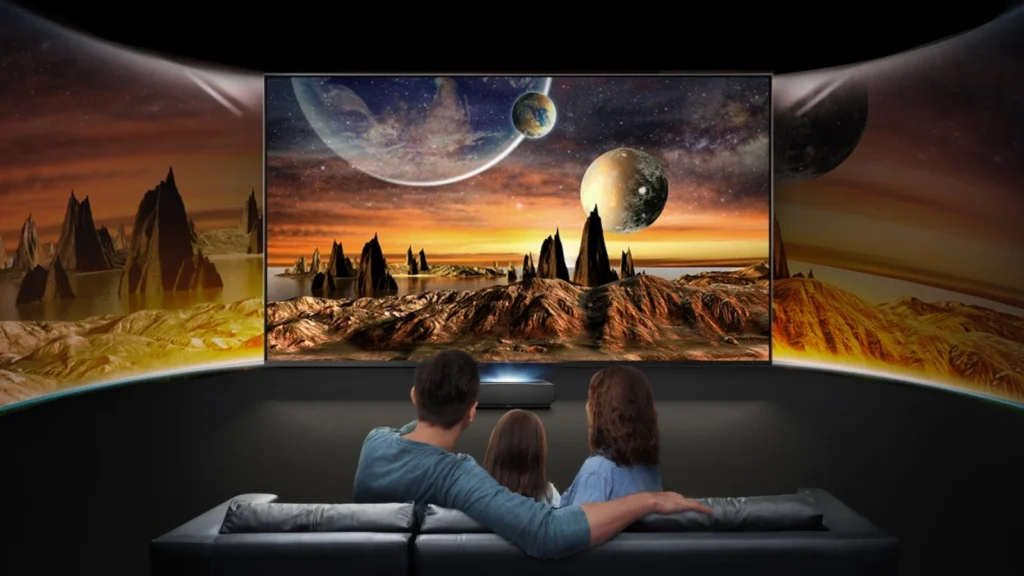
2. Enhanced Streaming and Broadcast Quality
Armored 8K Fiber Optic Cables are increasingly being used in the broadcasting industry, where high-quality, uncompressed video transmission is essential. As live streaming and broadcast services demand higher standards for visual and auditory output, these cables ensure that the original quality is maintained over the necessary transmission distances. This capability is crucial for delivering superior broadcast quality, meeting the industry’s stringent requirements for clarity and fidelity in both video and audio signals.

3. Technological Development and Innovation
Continuous innovation in fiber optic technology will enhance the capabilities of these cables and reduce their costs, thereby expanding their appeal and accessibility.
Miniaturization and Integration: Advances in cable technology might lead to smaller, more easily integrated fiber optic HDMI cables, increasing convenience and broadening their potential applications.
Affordability and Accessibility: As production techniques improve and demand increases, costs are expected to decrease, making fiber optic solutions more accessible to the average consumer.
Conclusion
The future of fiber optic HDMI cables is very promising. Their ability to support high-speed, high-resolution, and interference-free data transmission aligns perfectly with the trajectory of technological advancements and consumer demand. As various industries continue to adopt higher-quality digital systems, fiber optic HDMI cables will become a cornerstone of connectivity in an increasingly digital world. Whether for enhancing home entertainment, enabling cutting-edge professional applications, or supporting emerging fields, these cables are essential for future-oriented connectivity solutions.
FAQ
Q1: Is a fiber optic HDMI cable worth it?
A1: Yes, fiber optic HDMI cables can be worth it, especially if you need to transmit high-quality video and audio signals over long distances without loss of signal quality. These cables use optical fibers to carry the data, which means they are less susceptible to electromagnetic interference and can maintain high bandwidth over greater lengths compared to traditional copper HDMI cables. This makes them ideal for professional audiovisual setups, such as in theaters or large conference venues.
Q2: What is the difference between fiber optic HDMI and regular HDMI?
A2: The primary difference between fiber optic HDMI and regular HDMI cables lies in the materials and transmission methods used. Regular HDMI cables use copper conductors to transmit electrical signals, which can lead to signal degradation over long distances due to resistance and electromagnetic interference. In contrast, fiber optic HDMI cables convert the signal into light, which travels through optical fibers. This method allows them to maintain higher quality signals over longer distances without the interference issues seen in copper cables.
Q3: What is AOC cable used for?
A3: AOC cables, or Active Optical Cables, are used to transmit data over long distances with minimal signal loss. They are particularly useful in environments where high-resolution video and audio need to be transmitted, such as in professional broadcasting, large-scale public displays, conference rooms, and home theater setups. These cables are lightweight and more flexible compared to traditional copper cables, making them easier to install and manage.
Q4: What is the difference between HDMI ARC and optical Fibre?
A4: HDMI ARC (Audio Return Channel) and optical fiber cables serve different purposes. HDMI ARC is a feature of HDMI technology that allows audio signals to travel both ways between a TV and an audio system over a single HDMI connection, reducing the number of cables needed for a setup. Optical fiber cables, on the other hand, are used for transmitting digital audio signals using light, which can be beneficial for preventing electromagnetic interference. Thus, while HDMI ARC simplifies connections within an HDMI system, optical fiber cables excel in minimizing interference and maintaining signal quality over longer distances.
Q5: How do I know if I need a fiber optic HDMI cable?
A5: You may need a fiber optic HDMI cable if you experience signal degradation or interference with standard HDMI cables, especially over longer distances (e.g., over 10 meters). If your setup requires high-resolution video and audio transmission without loss of quality—for instance, in a large home theater, commercial displays, or broadcasting environments—fiber optic HDMI could be a better fit.
Q6: Can fiber optic HDMI cables support 4K and 8K resolutions?
A6: Yes, fiber optic HDMI cables are capable of supporting higher resolutions such as 4K and 8K, along with features like HDR (High Dynamic Range). Their high bandwidth capacity allows them to transmit large amounts of data required for these high-definition formats without compression, ensuring the best possible image and sound quality.
Q7: What is a main advantage of using fiber optic cable?
A7: The main advantage of using fiber optic cable is its ability to transmit data over long distances with minimal signal loss and without electromagnetic interference. Fiber optic cables use light to carry information, which allows them to maintain high bandwidth and signal integrity even across vast lengths. This makes them ideal for high-speed internet connections, large data transfers, and HD video and audio transmissions. Additionally, fiber optic cables are more secure, as they are difficult to tap into without being detected, providing enhanced security for data transmission.
Q8: How long can fiber HDMI run?
A8: Fiber optic HDMI cables can run significantly longer distances compared to traditional copper HDMI cables without losing signal quality. Typically, they can transmit high-quality signals up to 500 meters or more, depending on the specific cable and technology used. This makes them ideal for applications where long-distance transmission is necessary without compromising audio or video quality.
Q9: Do longer fiber optic HDMI cables lose quality?
A9: No, longer fiber optic HDMI cables do not typically lose quality like traditional copper HDMI cables. Fiber optic cables use light to transmit data, which allows them to maintain zero attenuation and high signal integrity over long distances without the attenuation caused by resistance and electromagnetic interference in copper cables. This makes them an excellent choice for applications that require high quality transmission over long distances, such as in large venues or complex audio-visual setups.
Quick Link to Fiber Optical HDMI Cables
-
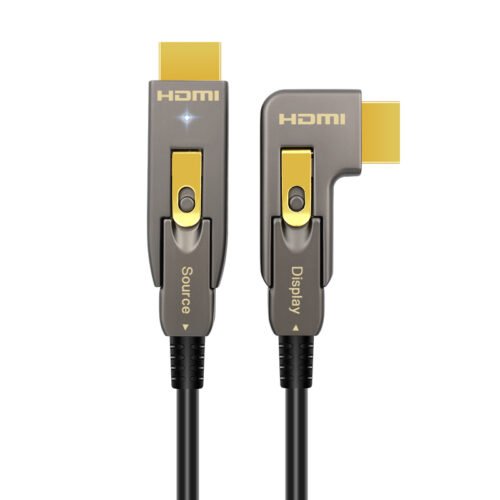 8K HDMI2.1 Fiber Optic Cable-Detachable-Latching-LED Indication,DM-Angled DM,48Gbps 4K/120Hz
8K HDMI2.1 Fiber Optic Cable-Detachable-Latching-LED Indication,DM-Angled DM,48Gbps 4K/120Hz -
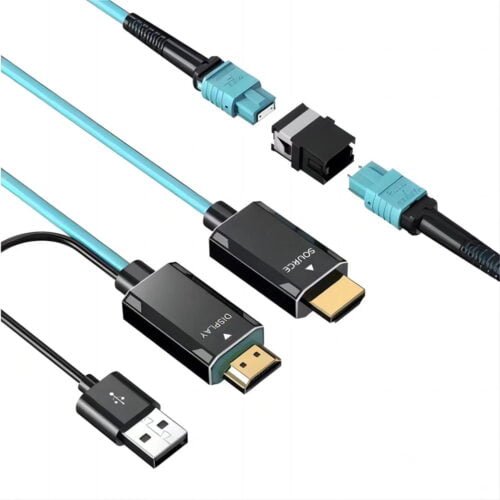 8K HDMI MPO Fiber Optic Extension Cable Kit-Detachable-300m-48Gbps-8K/60Hz & 4K/144Hz
8K HDMI MPO Fiber Optic Extension Cable Kit-Detachable-300m-48Gbps-8K/60Hz & 4K/144Hz -
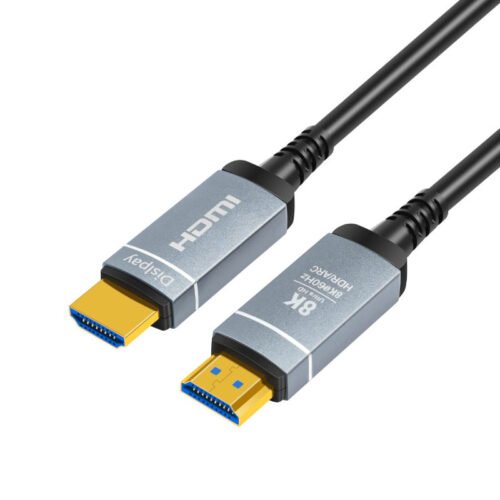 8K HDMI Fiber Optic Cable 100feet-HDMI 2.1-Aluminum Alloy Shell-8K/60Hz-48Gbps-Dynamic HDR 10 & eARC
8K HDMI Fiber Optic Cable 100feet-HDMI 2.1-Aluminum Alloy Shell-8K/60Hz-48Gbps-Dynamic HDR 10 & eARC -
 Super Slim 8K HDMI 2.1 Fiber Active Optical Cable-AM to AM-48Gbps
Super Slim 8K HDMI 2.1 Fiber Active Optical Cable-AM to AM-48Gbps -
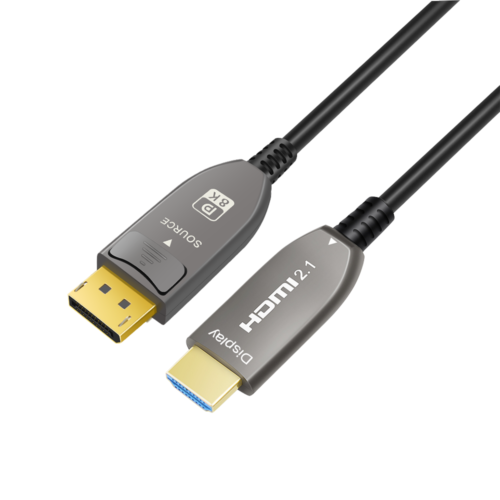 DisplayPort1.4 to HDMI Fiber Active Optical Cable-AOC-UHD 8K/60Hz,HDR,Black,20m
DisplayPort1.4 to HDMI Fiber Active Optical Cable-AOC-UHD 8K/60Hz,HDR,Black,20m -
 USB-C to HDMI Fiber Active Optical Cable-AOC-UHD 4K/60 Hz,HDR,Black,10 m (33 ft.)
USB-C to HDMI Fiber Active Optical Cable-AOC-UHD 4K/60 Hz,HDR,Black,10 m (33 ft.) -
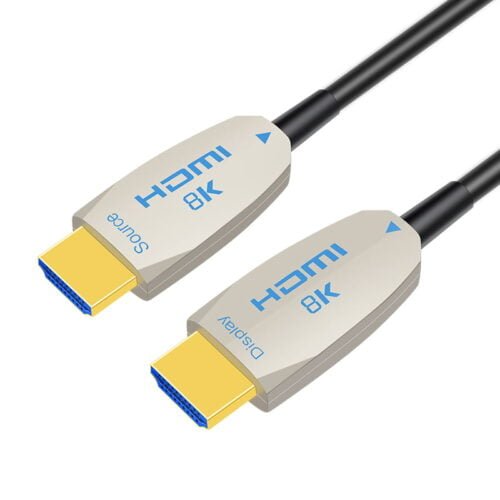 8K HDMI 2.1 AOC-Active Optical Cable-AM to AM-48Gbps
8K HDMI 2.1 AOC-Active Optical Cable-AM to AM-48Gbps -
 Detachable 8K Hybrid Active Optical HDMI Cable-Latching,DM-DM,48Gbps 8K@60Hz
Detachable 8K Hybrid Active Optical HDMI Cable-Latching,DM-DM,48Gbps 8K@60Hz -
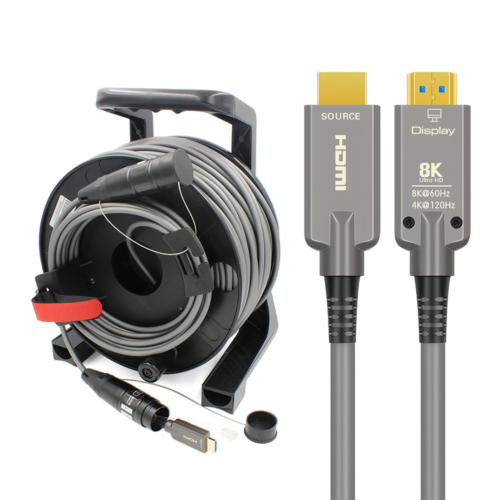 Armored 8K Fiber Optic HDMI 2.1 Active Optical Cable on Roxtone PCD 310 Drum
Armored 8K Fiber Optic HDMI 2.1 Active Optical Cable on Roxtone PCD 310 Drum


